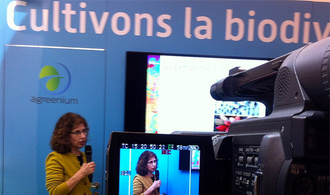Claire Neirac : "Un partage juste et équitable des ressources génétiques "
Written by Modified on the
Claire Neirac is a rights lawyer and intellectual property specialist with the Cirad. She talked to us about the importance of sharing genetic resources.
We know it is possible to "share biodiversity" by sharing information and knowledge of genetic resources. First, what is a genetic resource?
- A genetic resource can be defined as "plant,animal or microbial material containing functional units of heredity of actualor potential value." In other words, any biological resource that is used in research and development.
Why is it important to share these genetic resources?
- Sharing them is to conserve them, to avoid depletion of the resources themselves and the knowledge we have of them. This is at the very core of the Convention on Biological Diversity (CBD) adopted at the 1992 Rio Earth Summit. Three objectives underpin the Convention : the conservation of biological diversity, the sustainable use of its components and the fair and equitable sharing of benefits arising from the utilization of genetic resources.
You talk about “benefits arising from the utilization of genetic resources.” What are they?
- The CBD was completed in 2010 by the Nagoya Protocol, which provides a non-exhaustive list of monetary and non-monetary benefits attached to the sharing of benefits arising from the use of genetic resources and knowledge thereof. The monetary benefits include access rights, development charges and intellectual property. Non-monetary benefits include research collaboration, sharing the results of research and development, capacity building and training in technology transfer. Such benefits will enhance conservation and traceability of genetic resources, knowledge creation and encourage PhD students. The non-monetary benefits are primarily the avenue the Cirad envisages to explore in terms of the transfer of genetic material.
Can we achieve a "fair and equitable sharing" of these benefits?
- This sharing of benefits is highlighted in the third objective of the CBD. It is a pity, however, that some have adopted a commercial approach to this third objective, seeing only the monetary aspect. In my opinion, this goes against the sustainable use of genetic resources. It is striking, for example, how developing countries lack resources in this field, and to hear about their difficulties in simply following a genetic resource and in obtaining research reports. It is not possible to share genetic resources equitably if economic priorities are not the same in developing countries compared to developed countries in the North.
How did we go from free to controlled access to genetic resources?
- Before the 1992 Rio Earth Summit, there was no specific legislation in this area. Genetic resources were somehow part of the "common heritage of mankind". Subsequently, access principles to genetic resources and benefit-sharing were defined under the CBD. This Convention enables the signatory countries to define their national rules. Now, individual states define rules of access and benefit sharing in accordance with the principles laid down in the CDB. Each state is therefore responsible for what happens on its territory and may make rules to regulate individual agreements between users and providers for any transfer that takes place on its territory.
Why is it difficult to establish a linear relationship between a genetic resources and its use?
- It’s true that it is difficult to find a direct link between a genetic resource and its use or benefit. Most of the time, genetic resources are used in the form of pools by networks of scientific communities. This is a dynamic process : sharing genetic resources produces knowledge, which in turn optimizes the utilization of genetic resources. How should we measure the fraction of a genetic resource in new data? Sharing of genetic resources means sharing use as well as sharing benefits.


